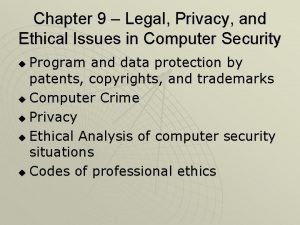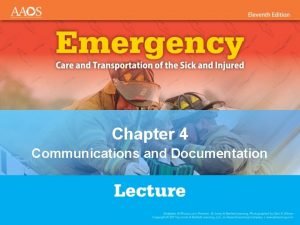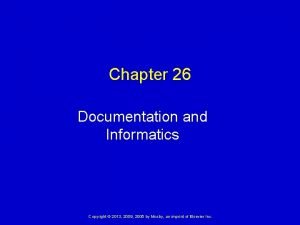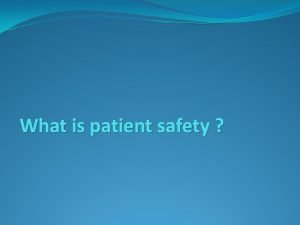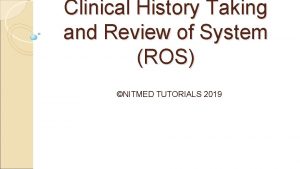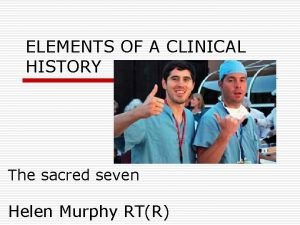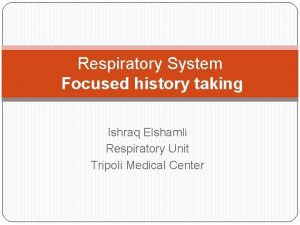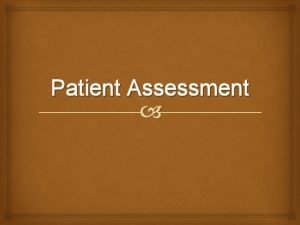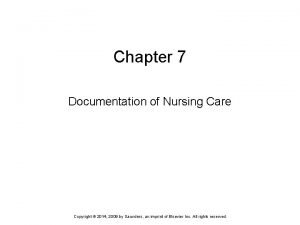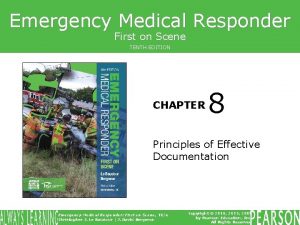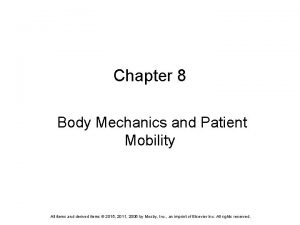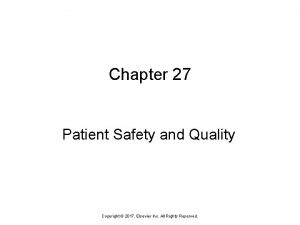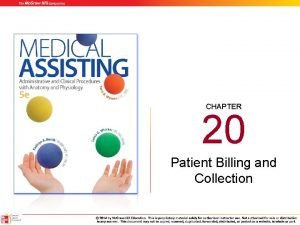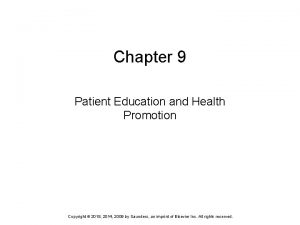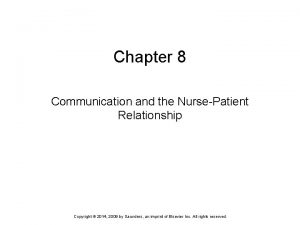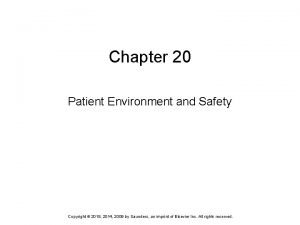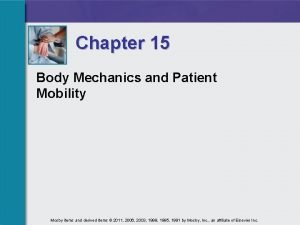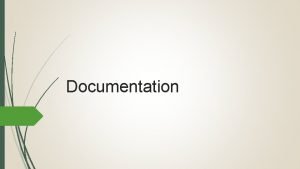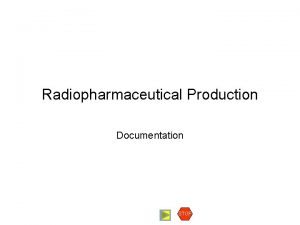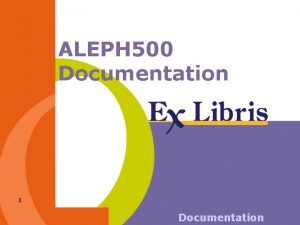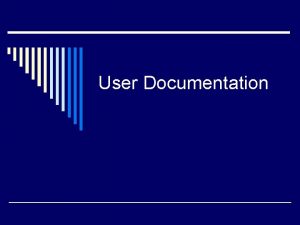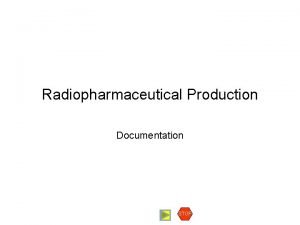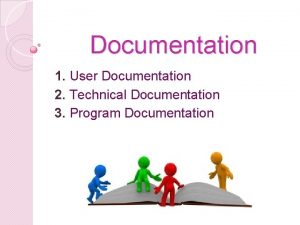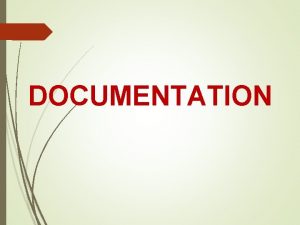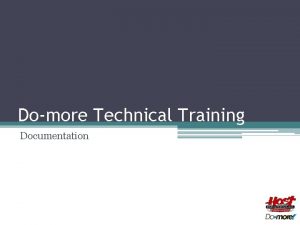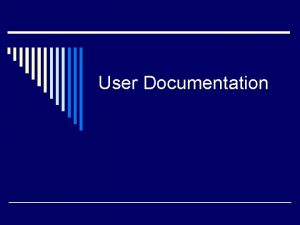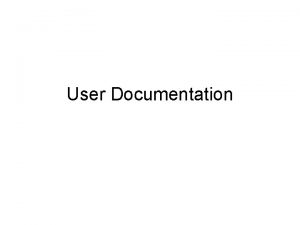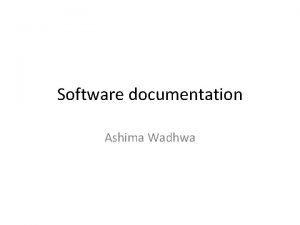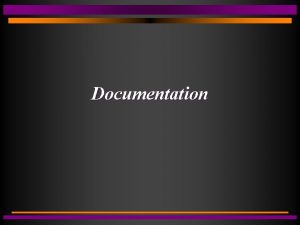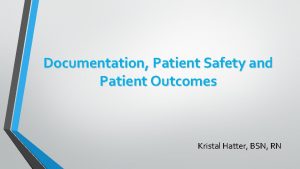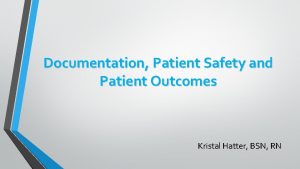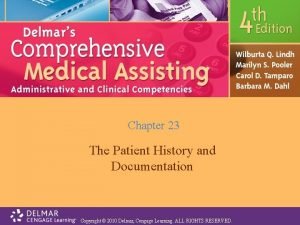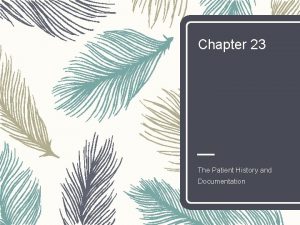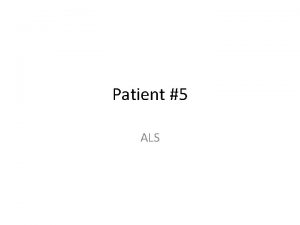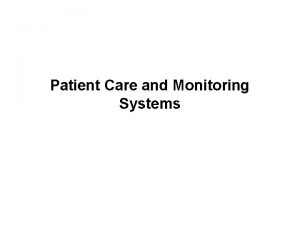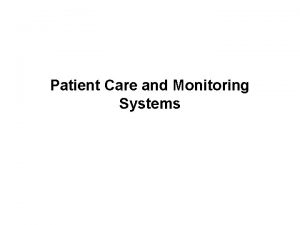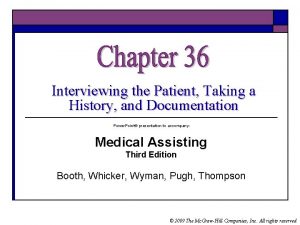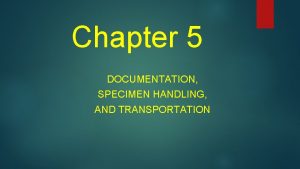Chapter 23 The Patient History and Documentation 2014





















































- Slides: 53

Chapter 23 The Patient History and Documentation © 2014 Cengage©Learning. 2014 Cengage All Rights Learning. Reserved. All Rights May not Reserved. be scanned, May not copied be scanned, copied or duplicated, or or posted duplicated, to a publicly or posted accessible to a publicly website, accessible in wholewebsite, or in part. in whole or in part.

The Purpose of the Medical History • Basis for treatment by primary care provider, on-call provider, any provider or specialist • Helps guide treatment for patient • Recalls previous treatment • Review notes and laboratory results © 2014 Cengage Learning. All Rights Reserved. May not be scanned, copied or duplicated, or posted to a publicly accessible website, in whole or in part.

The Purpose of the Medical History • Base for statistical analysis for: – Research – Insurance data – Health department notices • Health history and chart notes legal record of patient treatment © 2014 Cengage Learning. All Rights Reserved. May not be scanned, copied or duplicated, or posted to a publicly accessible website, in whole or in part.

Preparing for the Patient • Make certain: – Examination room ready – All supplies available – You review patient’s chart © 2014 Cengage Learning. All Rights Reserved. May not be scanned, copied or duplicated, or posted to a publicly accessible website, in whole or in part.

Preparing for the Patient • Bring patient from reception area to where interview will take place • Speak clearly and plainly • Make certain patient able to hear you • Determine if assistance is necessary © 2014 Cengage Learning. All Rights Reserved. May not be scanned, copied or duplicated, or posted to a publicly accessible website, in whole or in part.

Preparing for the Patient • Friendly greeting appreciated and helpful • Build rapport with patient • Use patient’s name often, making certain you pronounce it correctly • Think globally © 2014 Cengage Learning. All Rights Reserved. May not be scanned, copied or duplicated, or posted to a publicly accessible website, in whole or in part.

Preparing for the Patient • Introduce yourself and speak plainly Seat patient comfortably and sit face-to-face to begin interview>> © 2014 Cengage Learning. All Rights Reserved. May not be scanned, copied or duplicated, or posted to a publicly accessible website, in whole or in part.

A Cross-Cultural Model • Every patient interview is cross-cultural • Health and illness inseparable from social and cultural beliefs © 2014 Cengage Learning. All Rights Reserved. May not be scanned, copied or duplicated, or posted to a publicly accessible website, in whole or in part.

A Cross-Cultural Model • Patient’s chief concern: the illness • Patient’s idea of treatment success: managing illness • Provider’s chief concern: disease • Provider’s idea of treatment success: control disease problems © 2014 Cengage Learning. All Rights Reserved. May not be scanned, copied or duplicated, or posted to a publicly accessible website, in whole or in part.

A Cross-Cultural Model • Questions to ask patients – – – What do you think caused your problem? When do you think it started? What effect does it have on you? What are your concerns from this problem? What kind of treatment do you expect? • Respect patient’s perspective © 2014 Cengage Learning. All Rights Reserved. May not be scanned, copied or duplicated, or posted to a publicly accessible website, in whole or in part.

Patient Information Forms • Demographic data form – – – – Name and address Home, work, cell telephone numbers Date of birth Social Security number Insurance information Emergency contact person Release of information signature © 2014 Cengage Learning. All Rights Reserved. May not be scanned, copied or duplicated, or posted to a publicly accessible website, in whole or in part.

Patient Information Forms • Financial information form – – – Financial policy of practice Billing Insurance billing Co-payment billing Finance charges © 2014 Cengage Learning. All Rights Reserved. May not be scanned, copied or duplicated, or posted to a publicly accessible website, in whole or in part.

Patient Information Forms • Privacy information form – Since 2004, HIPAA limited circumstances in which individuals’ PHI can be used or disclosed – See http: //www. hhs. gov/ocr/privacy/ / for details – Civil penalties for failure to comply © 2014 Cengage Learning. All Rights Reserved. May not be scanned, copied or duplicated, or posted to a publicly accessible website, in whole or in part.

Patient Information Forms • Release of information form – Sent to former providers to obtain past medical records – In some cases can be used to allow sharing of information with family members © 2014 Cengage Learning. All Rights Reserved. May not be scanned, copied or duplicated, or posted to a publicly accessible website, in whole or in part.

Patient Information Forms • Medical history form – Present health history, including why patient being seen – Past health history, personal and family – Social history including marital status, sexual orientation, occupation © 2014 Cengage Learning. All Rights Reserved. May not be scanned, copied or duplicated, or posted to a publicly accessible website, in whole or in part.

Patient Information Forms • Medical history form – Military service dates and assignment – Body systems review/questionnaire – Medications currently taken (OTC and prescription) – Provider’s review of system (ROS) © 2014 Cengage Learning. All Rights Reserved. May not be scanned, copied or duplicated, or posted to a publicly accessible website, in whole or in part.

Computerized Health History • Patient-generated – Patient responds on computer to questions and reviews information with MA for completeness • Provider-generated – MA completes information on screen during patient interview © 2014 Cengage Learning. All Rights Reserved. May not be scanned, copied or duplicated, or posted to a publicly accessible website, in whole or in part.

The Patient Intake Interview • Interacting with the patient – – – – Put patient at ease Guide conversation Keep on track Obtains the most information Explain terms or concepts Remain professional Not be embarrassed or uncomfortable by answers © 2014 Cengage Learning. All Rights Reserved. May not be scanned, copied or duplicated, or posted to a publicly accessible website, in whole or in part.

The Patient Intake Interview • Interacting with the patient – Update medical history as needed – Document chief complaint © 2014 Cengage Learning. All Rights Reserved. May not be scanned, copied or duplicated, or posted to a publicly accessible website, in whole or in part.

The Patient Intake Interview • Displaying cultural awareness – Patient who does not speak English – Patient who is hearing impaired – If interpreter needed; complete business associate contract (HIPAA) – Cultural barriers addressed – Patient with mental disorder – MA listens and communicates with patient and provider © 2014 Cengage Learning. All Rights Reserved. May not be scanned, copied or duplicated, or posted to a publicly accessible website, in whole or in part.

The Patient Intake Interview • Being sensitive to patient needs – – Patient may be frightened, hostile, depressed Be open to nonverbal and verbal communication Maintain professional boundary Know when touch is appropriate © 2014 Cengage Learning. All Rights Reserved. May not be scanned, copied or duplicated, or posted to a publicly accessible website, in whole or in part.

The Patient Intake Interview • Being sensitive to patient needs – Be patient and understanding – Calm upset patients – Uncommunicative patients require special questioning techniques – Some patients have particular needs © 2014 Cengage Learning. All Rights Reserved. May not be scanned, copied or duplicated, or posted to a publicly accessible website, in whole or in part.

The Patient Intake Interview • Approaching sensitive topics – – – Environment private and free from distractions Ask questions in later stages of interview Use casual direct eye contact without staring Pose questions in matter-of-fact tone Adopt nonjudgmental demeanor Use “normalize” technique when appropriate © 2014 Cengage Learning. All Rights Reserved. May not be scanned, copied or duplicated, or posted to a publicly accessible website, in whole or in part.

Communication Across the Lifespan • Patient’s age important in communications – Infant/child • Communicate with two patients: parent and child – Older children • Child may do better without parent present – Teenagers • Old enough to make decision about being seen alone or with parent present © 2014 Cengage Learning. All Rights Reserved. May not be scanned, copied or duplicated, or posted to a publicly accessible website, in whole or in part.

Communication Across the Lifespan • Patient’s age important in communications – Older adults • May be accompanied by another adult • May request individual be present during interview • Good idea to have HIPAA waiver signed by patient © 2014 Cengage Learning. All Rights Reserved. May not be scanned, copied or duplicated, or posted to a publicly accessible website, in whole or in part.

The Medical Health History • Personal data from demographic form • Chief complaint • Present illness – Medications – Allergies – Other providers or alternative therapy practitioners being seen © 2014 Cengage Learning. All Rights Reserved. May not be scanned, copied or duplicated, or posted to a publicly accessible website, in whole or in part.

The Medical Health History • • Medical history Family history Social and occupational history Review of systems by physician or provider © 2014 Cengage Learning. All Rights Reserved. May not be scanned, copied or duplicated, or posted to a publicly accessible website, in whole or in part.

The Medical Health History • SOAP/SOAPER – S = Subjective data; patient’s complaint in his or her own words – O = Objective, observable, measurable findings – A = Assessment, probable diagnosis based on subjective and objective factors – P = Plan for treatment, medications, instructions, return visit information – E = Education for patient – R = Response of patient to education and care given © 2014 Cengage Learning. All Rights Reserved. May not be scanned, copied or duplicated, or posted to a publicly accessible website, in whole or in part.

The Medical Health History • CHEDDAR – C = Chief complaint, presenting problems, subjective information – H = History • Social and physical of presenting problem; contributing data – E = Examination, body systems review – D = Details of problem(s) and complaint(s) – D = Drugs and dosages; list of current medications, dosages, frequency – A = Assessment; diagnostic evaluation, further testing, medications – R = Return visit, if applicable © 2014 Cengage Learning. All Rights Reserved. May not be scanned, copied or duplicated, or posted to a publicly accessible website, in whole or in part.

The Medical Health History • Chief complaint (CC) – Specific reason that brought patient to see provider – Noted in as few words as possible; can be direct quote from patient – Subjective complaint: known by patient but cannot be seen or measured by provider © 2014 Cengage Learning. All Rights Reserved. May not be scanned, copied or duplicated, or posted to a publicly accessible website, in whole or in part.

The Medical Health History • Chief complaint characteristics – – – – Location Radiation Quality Severity Associated symptoms Aggravating factors Alleviating factors Setting and timing © 2014 Cengage Learning. All Rights Reserved. May not be scanned, copied or duplicated, or posted to a publicly accessible website, in whole or in part.

The Medical Health History • History of present illness – – – CC expanded to give more information and detail Allow patient to describe history in their own words CC characteristics helpful Often based on prior health problem Medications and allergies reviewed All medications to be listed © 2014 Cengage Learning. All Rights Reserved. May not be scanned, copied or duplicated, or posted to a publicly accessible website, in whole or in part.

The Medical Health History • Medical history – – Health problems Major illnesses Surgeries Allergies and medications (updated at least annually) – Update immunizations for adults © 2014 Cengage Learning. All Rights Reserved. May not be scanned, copied or duplicated, or posted to a publicly accessible website, in whole or in part.

The Medical Health History • Family history – – – Provide clues to patient’s present condition Hereditary and familial diseases and disorders Present ages of siblings, parents, grandparents Causes of their death and age at time of death Be sensitive to cultural variances © 2014 Cengage Learning. All Rights Reserved. May not be scanned, copied or duplicated, or posted to a publicly accessible website, in whole or in part.

The Medical Health History • Social history – – – Spouse/partner status Sexual habits Occupation Hobbies Use of alcohol, tobacco, recreational drugs or other chemical substances © 2014 Cengage Learning. All Rights Reserved. May not be scanned, copied or duplicated, or posted to a publicly accessible website, in whole or in part.

The Medical Health History • Social history – Lifestyles/behaviors that put patient at risk – May be necessary to inquire about home environment • • • Poor hygiene Frequent infections Smoke inhalation Burns Malnutrition Falls (especially in older adults) © 2014 Cengage Learning. All Rights Reserved. May not be scanned, copied or duplicated, or posted to a publicly accessible website, in whole or in part.

The Medical Health History • Review of systems (ROS) – – – Performed during physical examination Orderly and systematic check of each part of body Elicits information essential to diagnosis of disease Both positive and negative findings documented Helps to determine clinical diagnosis © 2014 Cengage Learning. All Rights Reserved. May not be scanned, copied or duplicated, or posted to a publicly accessible website, in whole or in part.

Patient’s Record and Its Importance • Confidential information • Foundation for planning patient care • Basis for communication among caregivers • Statistical analysis in research • Reporting infectious diseases to health department • Legal document © 2014 Cengage Learning. All Rights Reserved. May not be scanned, copied or duplicated, or posted to a publicly accessible website, in whole or in part.

Patient’s Record and Its Importance • HIPAA compliance – Paper record storage and computer/server areas – Fax machines – Workstations © 2014 Cengage Learning. All Rights Reserved. May not be scanned, copied or duplicated, or posted to a publicly accessible website, in whole or in part.

Patient’s Record and Its Importance • Contents of medical records – – Informed consent forms Physical examination outcomes Laboratory and diagnostic test results Diagnosis and plan of treatment © 2014 Cengage Learning. All Rights Reserved. May not be scanned, copied or duplicated, or posted to a publicly accessible website, in whole or in part.

Patient’s Record and Its Importance • Contents of medical records – – Surgical reports Progress reports Follow-up care Telephone calls related to care © 2014 Cengage Learning. All Rights Reserved. May not be scanned, copied or duplicated, or posted to a publicly accessible website, in whole or in part.

Patient’s Record and Its Importance • Contents of medical records – Discharge summary – Other communications (providers, laboratories, agencies) – Patient’s records from other providers – Medication history © 2014 Cengage Learning. All Rights Reserved. May not be scanned, copied or duplicated, or posted to a publicly accessible website, in whole or in part.

Patient’s Record and Its Importance • Continuity of Care record (CCR) – Developed by a number of medical groups – Makes it easier and more efficient to transport patient medical information between providers – Improves continuity of care and reduces errors © 2014 Cengage Learning. All Rights Reserved. May not be scanned, copied or duplicated, or posted to a publicly accessible website, in whole or in part.

Patient’s Record and Its Importance • Continuity of Care record (CCR) – – – Patient and provider information Insurance data Patient’s health status Recent care given Recommendations for future care Reason for referral or transfer © 2014 Cengage Learning. All Rights Reserved. May not be scanned, copied or duplicated, or posted to a publicly accessible website, in whole or in part.

Patient’s Record and Its Importance • Continuity of Care record (CCR) – Likely includes advanced directives – Completed by providers, nurses, medical assistants, ancillary personnel – Can include outpatient, community-based, inpatient services – Can be transferred electronically © 2014 Cengage Learning. All Rights Reserved. May not be scanned, copied or duplicated, or posted to a publicly accessible website, in whole or in part.

Methods of Charting/Documentation • Source-oriented medical records (SOMR) – Chronological set of notes for each visit – May be typed by medical transcriptionist from provider’s dictation © 2014 Cengage Learning. All Rights Reserved. May not be scanned, copied or duplicated, or posted to a publicly accessible website, in whole or in part.

Methods of Charting/Documentation • Problem-oriented medical records (POMR) – Database: medical history, results from laboratory and diagnostic tests, and physical examination (core of record) – Problem list: individually identified with assigned numbers © 2014 Cengage Learning. All Rights Reserved. May not be scanned, copied or duplicated, or posted to a publicly accessible website, in whole or in part.

Methods of Charting/Documentation • Problem-oriented medical records (POMR) – Diagnostic/treatment plan: provider’s plan for treating patient – Progress notes: entered on every problem initially recorded © 2014 Cengage Learning. All Rights Reserved. May not be scanned, copied or duplicated, or posted to a publicly accessible website, in whole or in part.

Electronic Medical Records (EMR) • Mandated by 2010 • Can be a part of TPMS – Available 24 hours a day – Can be accessed from outside location – Available to more than one person at a time © 2014 Cengage Learning. All Rights Reserved. May not be scanned, copied or duplicated, or posted to a publicly accessible website, in whole or in part.

Electronic Medical Records (EMR) • Can be a part of TPMS – Storage not a problem – Errors are less likely than handwritten data – Capability of “flagging” information or queries to providers – Standard rules for charting in both paper medical record and EMR pertinent © 2014 Cengage Learning. All Rights Reserved. May not be scanned, copied or duplicated, or posted to a publicly accessible website, in whole or in part.

Rules of Charting • Charting required for each medication, treatment/procedure, provider and medical assistant action – Must be accurate, clear, complete, timely, entered properly – “If it is not charted, it was not done. ” © 2014 Cengage Learning. All Rights Reserved. May not be scanned, copied or duplicated, or posted to a publicly accessible website, in whole or in part.

Rules of Charting • Abbreviations used in charting – – Used extensively to document information Some used as short-hand Some used to give exact meaning to finding Best not to use abbreviations when charting medications – Keep abbreviations to minimum – Use only standard abbreviations © 2014 Cengage Learning. All Rights Reserved. May not be scanned, copied or duplicated, or posted to a publicly accessible website, in whole or in part.

Rules of Charting • Chart organization – Chart notes in paper medical record kept in chronologic order (most recent first) – Kept in orderly fashion – Information needed easily gleaned by each member of clinic staff © 2014 Cengage Learning. All Rights Reserved. May not be scanned, copied or duplicated, or posted to a publicly accessible website, in whole or in part.
 Patient 2 patient
Patient 2 patient Uuu
Uuu Chapter 4 communications and documentation
Chapter 4 communications and documentation Chapter 26 documentation and informatics
Chapter 26 documentation and informatics Patient safety definition
Patient safety definition Socrates history taking
Socrates history taking Anamnesis sacred seven
Anamnesis sacred seven Opqrsta
Opqrsta History taking of patient
History taking of patient General history taking of patient
General history taking of patient Nursing documentation examples
Nursing documentation examples Chapter 8 principles of effective documentation
Chapter 8 principles of effective documentation Neurovascular assessment
Neurovascular assessment Chapter 27 patient safety and quality
Chapter 27 patient safety and quality Chapter 20 patient collections and financial management
Chapter 20 patient collections and financial management Chapter 9 patient education and health promotion
Chapter 9 patient education and health promotion Therapeutic communication techniques
Therapeutic communication techniques Chapter 20 patient environment and safety
Chapter 20 patient environment and safety Chapter 8 body mechanics and patient mobility
Chapter 8 body mechanics and patient mobility Hình ảnh bộ gõ cơ thể búng tay
Hình ảnh bộ gõ cơ thể búng tay Frameset trong html5
Frameset trong html5 Bổ thể
Bổ thể Tỉ lệ cơ thể trẻ em
Tỉ lệ cơ thể trẻ em Gấu đi như thế nào
Gấu đi như thế nào Tư thế worm breton
Tư thế worm breton Alleluia hat len nguoi oi
Alleluia hat len nguoi oi Các môn thể thao bắt đầu bằng tiếng bóng
Các môn thể thao bắt đầu bằng tiếng bóng Thế nào là hệ số cao nhất
Thế nào là hệ số cao nhất Các châu lục và đại dương trên thế giới
Các châu lục và đại dương trên thế giới Công của trọng lực
Công của trọng lực Trời xanh đây là của chúng ta thể thơ
Trời xanh đây là của chúng ta thể thơ Mật thư anh em như thể tay chân
Mật thư anh em như thể tay chân Phép trừ bù
Phép trừ bù Phản ứng thế ankan
Phản ứng thế ankan Các châu lục và đại dương trên thế giới
Các châu lục và đại dương trên thế giới Thơ thất ngôn tứ tuyệt đường luật
Thơ thất ngôn tứ tuyệt đường luật Quá trình desamine hóa có thể tạo ra
Quá trình desamine hóa có thể tạo ra Một số thể thơ truyền thống
Một số thể thơ truyền thống Cái miệng nó xinh thế chỉ nói điều hay thôi
Cái miệng nó xinh thế chỉ nói điều hay thôi Vẽ hình chiếu vuông góc của vật thể sau
Vẽ hình chiếu vuông góc của vật thể sau Thế nào là sự mỏi cơ
Thế nào là sự mỏi cơ đặc điểm cơ thể của người tối cổ
đặc điểm cơ thể của người tối cổ Thế nào là giọng cùng tên? *
Thế nào là giọng cùng tên? * Vẽ hình chiếu đứng bằng cạnh của vật thể
Vẽ hình chiếu đứng bằng cạnh của vật thể Fecboak
Fecboak Thẻ vin
Thẻ vin đại từ thay thế
đại từ thay thế điện thế nghỉ
điện thế nghỉ Tư thế ngồi viết
Tư thế ngồi viết Diễn thế sinh thái là
Diễn thế sinh thái là Các loại đột biến cấu trúc nhiễm sắc thể
Các loại đột biến cấu trúc nhiễm sắc thể Bảng số nguyên tố lớn hơn 1000
Bảng số nguyên tố lớn hơn 1000 Tư thế ngồi viết
Tư thế ngồi viết Lời thề hippocrates
Lời thề hippocrates

